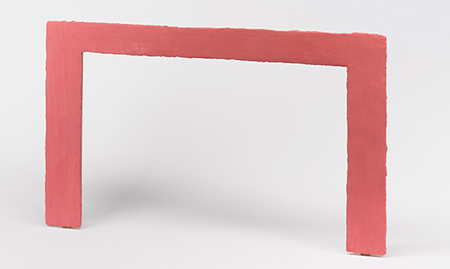
Continuing through October 28, 2023
The shapes pull you in first: biomorphic but not figurative, geometric but not hard-edged, kinda squishy, like a grilled cheese sandwich left too long in a hot car. Then there’s the color palette, straight out of kindergarten memories, and the surfaces, which appear malleable, halfway between wet and dry, like Play-doh. David Schell’s “Casual Plans” hook you with these paradoxes, occupying a middle ground that blends high minimalism, irony, and post-irony.
The show’s 31 mixed-media works begin as shaped birchwood panels, mostly soft-edged quadrilaterals. Schell primes them with powdered pumice, troweling it on, smoothing it out, and letting it dry. He then oil-paints a ground in small, tousled brushstrokes, squiggly and tacky-textured, unapologetically foregrounding evidence of the artist’s hand. Multiple layers of paint create shapes within the larger forms, and they are then finished with cold wax for a quality that’s the antithesis of slick.
Compositionally he sometimes bifurcates forms chromatically, as seen in “Locale: Green and Teal” and “Locale: Ochre and Black.” He also scores them with thick vertical lines in high relief, as in “Bearings: Informal Pattern” and “Informal Gravity.” He may subdivide and score simultaneously, as in “Contain/Carry,” paint his ground and lines the same color, as in “Bearings (Warm White),” or showcase a single hue, as in a sub-series called “Locale.” “Bearings in Six Parts” playfully groups relational shapes, while other works nest rhombuses (“Closer: Purple on Brown”) or irregular forms (“Slice of Moon”) within the shaped panels. Perhaps the show’s most elegant entry, the mustard-yellow “Open,” presents a freestanding square with an open center and deckled edges. It’s timeless, iconic, austere, yet tempered with an endearing peek-a-boo naïveté.
The paintings are floated off the wall with concealed strips of hemlock wood, lending shadow play and a wall-sculpture presence. Three works are freestanding sculptures, titled “Post and Lintel,” each subtitled after its color schemes. With their stripped-down simplicity, they evoke Minoan ruins. This marks the first time Schell has exhibited sculpture; he began experimenting with the medium only six months ago.
Earlier, I alluded to minimalism and irony superimposed over post-irony. The ironic quality comes from appropriating Ellsworth Kelly-like forms (Schell was captivated by Kelly’s work as an M.F.A. candidate at the School of the Art Institute of Chicago), then transmogrifying them into a kind of Romper Room fantasia, as if mocking minimalism’s at times ponderous self-importance. The post-irony blows in on the paintings’ breezy insouciance and their seductive indulgence of our inner child.
Schell is a Gen Xer born in 1970. As a generation we’ve been construed as uniquely post-ironic, arriving between the Boomers’ change-the-world earnestness and the digitally saturated world-weariness of the millennials. We tend toward a blithely reverential, rather than skeptical, attitude toward the pop-culture minutiae of our youth. This resonates with Art Alexakis of Everclear’s 2000 hymn to arrested development, “AM Radio.” Our response to Schell’s Crayola-colored reverie is akin to the Xers in Ben Stiller’s “Reality Bites” singing along to “Schoolhouse Rock:” “Conjunction Junction, what’s your function?”
We’re not poking fun at Play-doh playtime, nor are we looking back on it with knowing ennui; no, we’re still really digging it, still thinking it’s cool, still up for cracking open a can and playing with it right now! That’s the central appeal of these works: they enable us to co-inhabit the art-historical context of geometric abstraction and the emotional immediacy of childhood regression.
Schell gracefully pulls off this double-coding as a conceptualist while being able not to take himself too seriously. In his artist statement, he parses the impact of meta-systems and structures on the phenomena of stability, transformation, and improvisation. This is evident in his nested forms, the D.I.Y. irregularity of their contours and surfaces contrasting with the precision of their geometries. However, any tendency toward art-school grandiloquence is held mercifully in check by a tongue held firmly in cheek.
